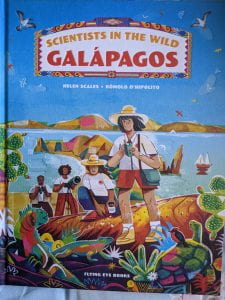I am delighted that I have again been asked to share some fabulous Information books with you, as part of #NNFN2023. The theme of this year’s blog tour is “Wonderful Water” and if you check out the hashtag you will discover a fantastic selection of books for both home and school. the two books that I have been asked to review are from Flying Eye books and although they are written for different series, they both have the same author; however, there are two different illustrators, which brings a variation to the look and feel of the books.

Flying Eye, 9781838740931
Scientist in the Wild: Galapagos by Helen Scales and Romolo D’Hipolito
This gives us a look at one of the most inaccessible areas of the world, although this is less the case than it was even 30 years ago. The book is framed around the work of 7 scientists, aboard the research ship Sula and it seems to be aimed at KS1 and lower KS2. The book is full of illustrations and the sections of text are short, with an overview and then more detail about specific creatures or environments. Some of the facts that we see are quite shocking; for instance there used to be a population of about 1,000 on the islands, but this has grown to about 30,000 and there are around 250,000 visitors (tourists) every year. In the book we get to see the work of the scientists and to build our understanding of the changes that mankind is bringing to the area. There is a fascinating section about how they tag Tiger Sharks and I was really taken by the description of something called “tonic immobility”, where the shark is turned on its back and goes into a trance like state. The whole book is full of amazing information about the wildlife, flora and history of the Galapagos. We always think of the islands in relation to Charles Darwin, but this title shows us that adaption to the environment is still going on and that we have lots of valuable lessons to learn about saving the natural world.
Earth’s Incredible Places: The Great barrier Reef by Helen Scales and Lisk Feng

Flying Eye, 9781838741471
This second title is about one of the most incredible natural wonders of the world and one that is suffering because of the climate change that is affecting water temperatures in the oceans. Again, this is aimed at lower KS2 and also KS1 , with the same clarity of text, but with longer sections which require a bit more reading stamina. The author has not limited herself to the coral and fish who live in the reef, but also covers the links with Aboriginal people throughout history and then the arrival of westerners and the impact that they made on the environment. The sections about plastic pollution and about the use of fossil fuels brings the story up to date and highlights the issues that need addressing urgently. The illustrations are so full of colour and life, but they are all very different, depending on the subject that is being discussed. For example the section about the Aboriginal people and some of their beliefs, is very subdued with a sense that they hark back to the wonderful rock drawings that are found in tribal lands. In contrast, we have the bright, vivid colours of creatures such as starfish and octopuses, whilst the cover itself uses extremely bright, almost fluorescent colours, that really catch the eye.
Both of these books make wonderful introductions to the oceans that surround us and the immense diversity of wildlife, both flora and fauna that are found there. However, they also highlight the importance of trying to improve the quality of the environment and not destroy the world in which we live. These books will make an excellent addition to the school or public library and will spark discussion about “Wonderful Water”.
